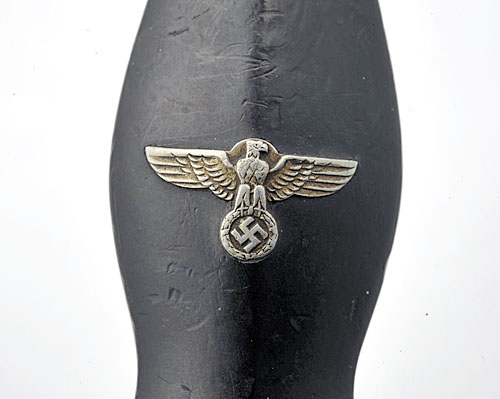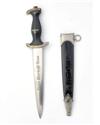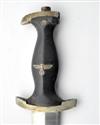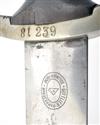Product Details
GOTTLIEB HAMMESFAHR, SOLINGEN,
AN EARLY 'SS' 1933 PATTERN 'HOLBEIN' DRESS DAGGER,
circa 1934, with double edged 8 3/4in. blade etched with the motto ' MEINE EHRE HEIST TREUE'' (my honour is loyalty) and makers mark to the reverse, black wooden grip inlaid with an eagle and swastika and the 'SS' roundel to top of hilt, solid cast fittings with the service number '81239' stamped over a roman numeral 'III' on the bottom crossguard (loss to right hand side of upper guard) TOGETHER WITH an original black painted metal scabbard from a slightly later example with plated chape and throat (blade with slight staining mild losses to plating on scabbard fittings finish)
Provenance: Without a doubt, the SS was the most feared, despised and infamous organisation of the Third Reich. The SS was formed in 1925 as a small sub-unit of the SA with the mission of serving as the Fuhrer's personal bodyguard. The SS remained insignificant until 1929, when it was placed under the command of Heinrich Himmler. After the "Night of the Long Knives" and the purge of the SA in 1934, the SS became independent, gained control over the national police forces and expanded into a massive organisation. Members of the SS were picked for their mental and physical adeptness and were recognised as the "elite" within the Nazi Party. A member had to be at least twenty-one and undergone a long probationary period of eighteen months. During this period, the candidate was tested rigidly to observe how well he lived up to the tests of faith, honour, and unconditional obedience. The SS was in reality a complex political and military organisation made up of three separate and distinct branches, all related but equally unique in their functions and goals. The Allgemeine-SS (General SS) was the main branch of the SS, and it served a political and administrative role within the Third Reich and occupied lands. The SS-Totenkopfverbande (SS Deaths Head Organisation) performed security duties at concentration camps and also formed fighting units assigned to the Wehrmacht for active service. The Waffen-SS (Armed SS) was formed from the SS-Verfungstruppe after the Campaign in France in 1940, and became an elite military formation of nearly 900,000 men by the time WWII was over. It comprised of 38 divisions which operated under the control of the Heer (Army) during campaigns. Its famed divisions include the 'Adolph Hitler Liebstandarte' and 'Das Reich'. The Waffen SS built a formidable reputation for bravery and skill as well as notorious atrocities during the war.
The SS dagger was introduced in December 1933 and was based on a similar design of the "Holbien Dagger" (see Lot 350 for more information on the Holbien dagger). The grip was black in colour and had the SS runes inserted at the top of the grip in a small circular "button". The S Rune signifies Wholeness and the Sun and all that is good, ironically its meaning is also to use the powers of good to vanquish evil. The upper and lower crossguards were the same curved design as the SA dagger. On early made daggers such as the one offered here, the crossguards are solid nickel and will display a marking of a Roman numeral I, II or III. This practice stopped in late 1935. Grips are made of a dark ebony wood. In many cases this wood has too much brown grain and was dyed with a black vegetable pigment to give the grip a black appearance. The scabbard had a black oxide finish with a clear lacquer overcoat. The scabbard fittings on early daggers are solid nickel and look the same as fittings found on the SA dagger. From February 1934 the daggers were only ordered through SS headquarters and issued through the three main SS Uniform distribution centres at Munich, Dresden and Berlin. After the daggers had passed quality inspection the reverse of the crossguard was stamped by the issue centres with I, II or III respectively. Since the early daggers were owned by the state prior to 1936, early SS daggers can have a punch die number grouping found on the underside of the crossguard for officer grade or the back of the crossguard for NCO and Enlisted Man grades. Crossguards can also show areas where these numbers have been removed after being turned back in to SS distribution centres. As of late 1936 the SS dagger came under the complete control of the RZM authority with the result that the old SS crossguard stamping was phased out and the RZM logo and the relevant manufacturer's number was added to the blade.
After 1936 the dagger scabbard was painted black rather than the oxide finish due to cost cutting efforts as well as uniformity in colour and texture. All fittings were changed to a low quality base metal with nickel plating that tends to peel and bubble. The SS dagger was given a special status and was only presented to the owner on 9th November each year at the SS Anwarter, or candidate ceremony, when he qualified to be a SS 'Mann'. It was made a disciplinary matter for an SS 'mann' to dispose of, or lose their dagger because it was considered a symbol of their office. From January 1935 any SS 'mann' dismissed from service had to hand back their dagger, however if an SS 'mann' retired, a certificate was issued which allowed them to keep their dagger. The SS pattern 1933 dagger was withdrawn from production in 1942.
Estimate £500-700







